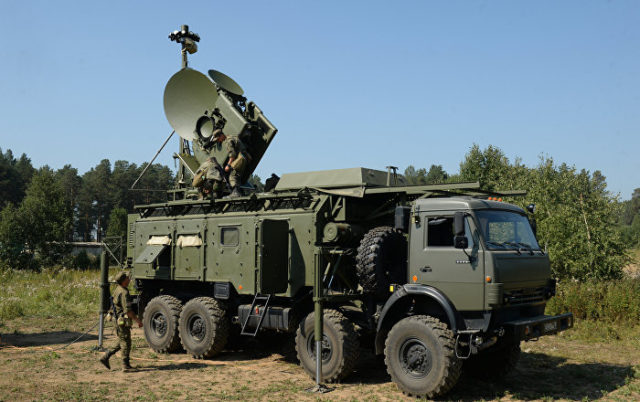
‘Syrian Lessons’ and Russia’s ‘Asymmetric Response’ to the US
Publication: Eurasia Daily Monitor Volume: 14 Issue: 118
By:

The Russian military operation in Syria has highlighted “urban warfare,” information security and electronic warfare (EW) as crucial elements of how Moscow envisions the “wars of the future” will be fought. However, Russia’s top brass is currently allocating a central role to the development of EW capabilities. Increasingly viewed by Russian military strategists as a pivotal tool for gaining and maintaining information superiority over its adversaries in future conflicts, Russia’s growing emphasis on the development of EW is inseparable from two events that occurred soon after Russia went into Syria. First was the November 2015 downing of a Russian Su-24 bomber by Turkish jets after it had strayed into Turkey’s airspace. The second incident, reported on later that same month, involved Turkey deploying Koral electronic warfare complexes on its southern border in order to “dazzle” (blind) Russian S-400 air-defense missile systems that Moscow had just brought into Syria (TASS, December 1, 2015).
Incidentally, speaking from a historical prospective, Syria first became a training ground for the Soviet Army to test its EW capabilities as far back as 1982, following the outbreak of hostilities in Lebanon. And Moscow renewed those efforts in October 2015, when it deployed the Krasukha-4 multifunctional jamming station to the Hmeymin airbase (Obzor.press, October 22, 2015), thus signaling a qualitatively new stage of Russian engagement in the Syrian civil war.
Analysis of Russia’s performance in Syria when it comes to electronic warfare poses a number of challenges, of which the most important is the lack of uniformity in assessments produced by top Russian military experts. Some Russian sources clearly overestimate Russia’s EW capabilities, asserting their total superiority over foreign analogues. Whereas others argue that “the lack of precision-guided munitions at the terrorists’ disposal have made Russian systems such as the ‘Krasuha’ and ‘Khibiny’ almost irrelevant” on the Syrian battlefield (Tvzvezda.ru, August 8).
Still, empirical evidence suggests that events in Syria (and of course in Ukraine—see EDM, May 24) have spurned the Russian side to increase both its theoretical and practical efforts in upgrading EW capabilities. The most recent trends in this domain include:
- Import substitution and modernization: This past summer, the first deputy director of Concern Radio-Electronic Technologies (KRET), Vladimir Zverev, declared that “Russia has been able to fully substitute Ukrainian components in domestically produced EW technologies” (Tvzvezda.ru, July 18). This development signifies that Russia has finally overcome its pre-2013 dependency on Ukraine in this sector. Moreover, KRET has reportedly begun work on a new land-based EW system designed to “replace” the Krasuha-2 and Krasuha-4 jamming stations (Tvzvezda.ru, July 21), which might have a revolutionary effect on Russia’s EW industry as such. Moreover, some sources have revealed that Russia has finalized work on a radio-photonic radar for a future sixth-generation fighter jet that will one day replace the Su-57 (T-50). The invention is said to be superior to “all existing radars when it comes to its power and range” (TASS, July 27). According a to top-ranking KRET functionary, Vladimir Mikheev, the new device “will burn out the eyes of the missiles looking at us.”
- Spoofing, jamming and deceiving: Allegedly, KRET has created a new reconnaissance complex that can function even under “extremely difficult radio-electronic conditions” (Tvzvezda.ru, July 18). Another potential invention—the Tarantul aircraft electronic countermeasures complex (ECM), which has been undergoing testing since 2007—will be integrated onboard the Su-34 fighter-bomber. One such system, when integrated into a single Su-34, is said to be capable of protecting a group of aircraft from enemy radar; and it has been described as “the future of Russian EW” (RIA Novosti, August 28).
- New type of radio connection: On August 25, the head of the Armed Forces Communication Chief Department and the deputy head of the General Staff, Lieutenant-General Khalil Arslanov, stated that the Russian Armed Forces tested in Syria a new type of “secure communications.” This system could effectively replace previous models (used by the Syrian Army) that were discredited in the course of the Palmyra, Deir ez-Zor and Idlib operations (Rosbalt, August 25). The main idea behind Russia’s new invention is based on the use of so-called “trunked systems” (radial-zonal systems) of communication, capable of an automatic distribution of channels among different user groups.
Russia’s conceptual approach to the development of EW capabilities was recently outlined by the editor-in-chief of Arsenal Otechestva, Victor Murakhvoskii, who specifically defined it as an “asymmetric response” (Pravdinform, August 28). The expert argued that Russia (due to its economic hardships and the smaller size of its domestic economy) is unable to directly engage the United States in competition in all areas and domains. Instead, he suggested, Russia needs to achieve “technological superiority in key branches of the domestic Armed Forces.” Given Russian perceptions of how the “wars of the future” will be fought, Murakovskii identified air, naval and EW capabilities as prime capabilities in which Russia has to develop its superiority.
On the other hand, it might well be expected that in light of the experience gained in Ukraine and Syria, Russia will also attempt to focus on “cyber warfare” (primarily cyber operations) and “electronic warfare.” Such an emphasis would become apparent if the Russian Armed Forces are repeatedly observed carrying out military exercises whereby they practice corrupting or disabling a simulated adversary’s Command, Control, Communications, Computers, Intelligence, Surveillance and Reconnaissance (C4ISR) systems.
In the final analysis, when assessing the key trends and developments in Russia’s EW capabilities being honed in Syria, one needs to keep in mind that aside from being an actual battlefield, Syria has also become a theater of violent information warfare (primarily information-psychological operations). In such an environment, truth and disinformation are not easily distinguishable. Thus, Russian claims regarding EW should be treated with a healthy dose of skepticism.



